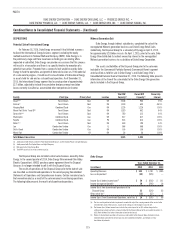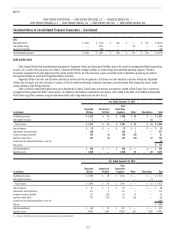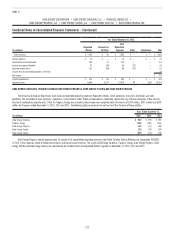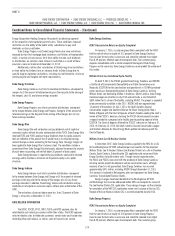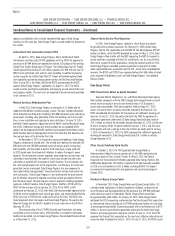Duke Energy 2015 Annual Report Download - page 143
Download and view the complete annual report
Please find page 143 of the 2015 Duke Energy annual report below. You can navigate through the pages in the report by either clicking on the pages listed below, or by using the keyword search tool below to find specific information within the annual report.
123
PART II
DUKE ENERGY CORPORATION • DUKE ENERGY CAROLINAS, LLC • PROGRESS ENERGY, INC. •
DUKE ENERGY PROGRESS, LLC • DUKE ENERGY FLORIDA, LLC • DUKE ENERGY OHIO, INC. • DUKE ENERGY INDIANA, INC.
Combined Notes to Consolidated Financial Statements – (Continued)
Retired generation facilities. Duke Energy Florida earns a full return
on a portion of the regulatory asset related to the retired nuclear plant currently
recovered in the nuclear cost recovery clause (NCRC), with the remaining
portion earning a reduced return. Duke Energy Carolinas earns a return on the
outstanding retail balance with recovery periods ranging from five to 10 years.
Duke Energy Progress earns a return on the outstanding balance with recovery
over a period of 10 years for retail purposes and over the longer of 10 years or
the previously estimated planned retirement date for wholesale purposes. Duke
Energy Indiana earns a return on the outstanding balances and the costs are
included in rate base.
Debt fair value adjustment. Purchase accounting adjustment recorded
to state the carrying value of Progress Energy at fair value in connection with the
2012 merger. Amount is amortized over the life of the related debt.
Net regulatory asset related to income taxes. Regulatory assets
principally associated with the depreciation and recovery of AFUDC equity.
Amounts have no impact on rate base as regulatory assets are offset by
deferred tax liabilities. The recovery period is over the life of the associated
assets. Amounts for Duke Energy, Duke Energy Carolinas, Progress Energy and
Duke Energy Progress include regulatory liabilities related to the change in the
North Carolina corporate tax rate discussed in Note 22.
Nuclear asset securitizable balance, net. Represents the balance
associated with Crystal River Unit 3 retirement approved for recovery by the
FPSC on September 15, 2015, and the deferred operating expenses expected to
be securitized in 2016 upon issuance of the associated bonds. The regulatory
asset balance is net of the AFUDC equity portion of the $1.283 billion amount
approved by the FPSC. The regulatory asset balance approved for recovery by
the FPSC will earn a reduced return until the expected bond issuance, after
which it will earn a return in rates to recover the interest costs of the associated
debt. Once bonds are issued, the balance will be recovered over approximately
20 years. This regulatory asset is not included in rate base.
Hedge costs and other deferrals. Amounts relate to unrealized gains
and losses on derivatives recorded as a regulatory asset or liability, respectively,
until the contracts are settled. The recovery period varies for these costs and
currently extends to 2048.
DSM/EE. The recovery period varies for these costs, with some currently
unknown. Duke Energy Carolinas, Duke Energy Progress and Duke Energy Florida
are required to pay interest on the outstanding liability balance. Duke Energy
Carolinas, Duke Energy Progress and Duke Energy Florida collect a return on
DSM/EE investments.
Grid Modernization. Represents deferred depreciation and operating
expenses as well as carrying costs on the portion of capital expenditures placed
in service but not yet reflected in retail rates as plant in service. Recovery period
is generally one year for depreciation and operating expenses. Recovery for
post-in-service carrying costs is over the life of the assets. Duke Energy Ohio is
earning a return on these costs.
Vacation accrual. Generally recovered within one year.
Deferred fuel and purchased power. Represents certain energy
related costs that are recoverable or refundable as approved by the applicable
regulatory body. Duke Energy Florida amount includes capacity costs. Duke
Energy Florida earns a return on the retail portion of under-recovered costs.
Duke Energy Ohio earns a return on under-recovered costs. Duke Energy Florida
and Duke Energy Ohio pay interest on over-recovered costs. Duke Energy
Carolinas and Duke Energy Progress amounts include certain purchased power
costs in both North Carolina and South Carolina and costs of distributed energy
resource programs in South Carolina. Duke Energy Carolinas and Duke Energy
Progress pay interest on over-recovered costs in North Carolina. Recovery period
is generally over one year. Duke Energy Indiana recovery period is quarterly.
Nuclear deferral. Includes (i) amounts related to levelizing nuclear plant
outage costs at Duke Energy Carolinas in North Carolina and South Carolina,
and Duke Energy Progress in North Carolina, which allows for the recognition of
nuclear outage expenses over the refueling cycle rather than when the outage
occurs, resulting in the deferral of operations and maintenance costs associated
with refueling and (ii) certain deferred preconstruction and carrying costs at
Duke Energy Florida as approved by the FPSC primarily associated with Levy,
with a final true-up to be filed by May 2017.
Post-in-service carrying costs and deferred operating expenses.
Represents deferred depreciation and operating expenses as well as carrying
costs on the portion of capital expenditures placed in service but not yet
reflected in retail rates as plant in service. Duke Energy Carolinas, Duke Energy
Progress, Duke Energy Ohio and Duke Energy Indiana earn a return on the
outstanding balance. Duke Energy Florida earns a return at a reduced rate. For
Duke Energy Ohio and Duke Energy Indiana, some amounts are included in rate
base. Recovery is over various lives, and the latest recovery period is 2082.
Gasification services agreement buyout. The IURC authorized Duke
Energy Indiana to recover costs incurred to buyout a gasification services
agreement, including carrying costs through 2018.
Transmission expansion obligation. Represents transmission
expansion obligations related to Duke Energy Ohio’s withdrawal from
Midcontinent Independent System Operator, Inc. (MISO).
MGP. Represents remediation costs for former MGP sites. In November
2013, the PUCO approved recovery of costs incurred through 2019. Duke Energy
Ohio does not earn a return on these costs.
NCEMPA deferrals. Represents retail allocated cost deferrals and
returns associated with the additional ownership interest in assets acquired
from NCEMPA discussed in Note 2. The North Carolina retail allocated costs are
generally being recovered, over a period of time between three years and the
remaining life of the assets purchased, through a rider that became effective on
December 1, 2015. The South Carolina retail allocated costs are being deferred
until Duke Energy Progress’ next general rate case, earning a return pursuant to
an order received from the PSCSC.
East Bend deferrals. Represents both deferred operating expenses and
deferred depreciation as well as carrying costs on the portion of East Bend
that was acquired from Dayton Power and Light and that had been previously
operated as a jointly owned facility. Recovery will not commence until the
settlement of the next rate case in Kentucky. Duke Energy Ohio is earning a
return on these deferred costs.
Costs of removal. Represents funds received from customers to cover the
future removal of property, plant and equipment from retired or abandoned sites
as property is retired. Also includes certain deferred gains on NDTF investments.
Amounts to be refunded to customers. Represents required rate
reductions to retail customers by the applicable regulatory body. The period of
refund for Duke Energy Indiana is through 2017.
Storm reserve. Duke Energy Carolinas and Duke Energy Florida are
allowed to petition the PSCSC and FPSC, respectively, to seek recovery of named
storms. Funds are used to offset future incurred costs.
RESTRICTIONS ON THE ABILITY OF CERTAIN SUBSIDIARIES TO MAKE
DIVIDENDS, ADVANCES AND LOANS TO DUKE ENERGY
As a condition to the approval of merger transactions, the NCUC,
PSCSC, PUCO, KPSC and IURC imposed conditions on the ability of Duke
Energy Carolinas, Duke Energy Progress, Duke Energy Ohio, Duke Energy
Kentucky and Duke Energy Indiana to transfer funds to Duke Energy
through loans or advances, as well as restricted amounts available to pay
dividends to Duke Energy. Certain subsidiaries may transfer funds to Duke




